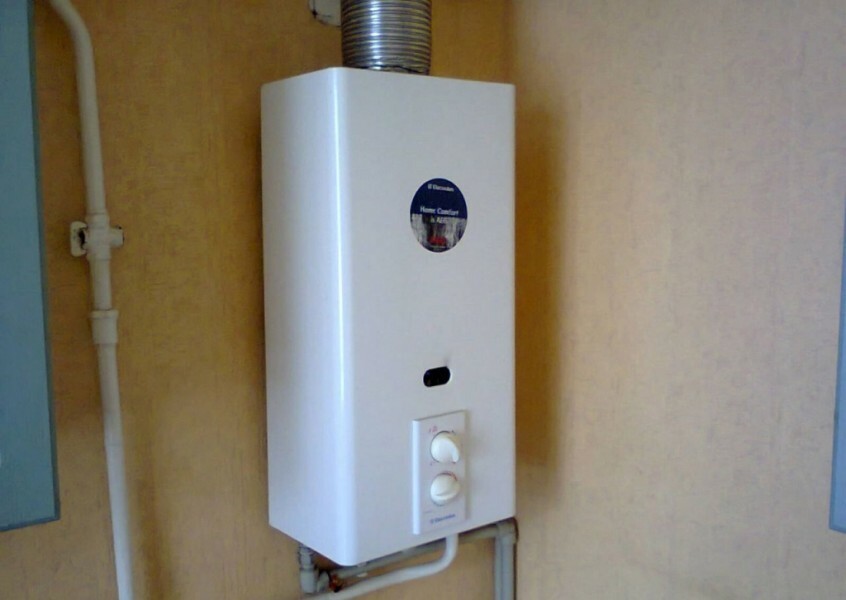
creativecommons.org
The advantage of a gas heating system is that it heats water several times faster than electrical counterparts, while the cost of consumables (utilities) is much less. Therefore, columns and snatched the championship among all types of water heating systems.
In this article we will talk about why the gas water heater does not work well, namely: why the gas water heater does not heat the water, how to deal with it and what you can do yourself. Just 2 minutes of your time will give more results than a service center. Let's start!
The content of the article
- Why the column does not heat up - it all depends on one of the details
- The geyser does not heat water well: key reasons
- Why the geyser does not heat water well: the first reason is blockage
- Heat exchanger wear is the second reason why the geyser does not heat water
- The geyser stopped heating water - there is not enough pressure in the system itself
- Why the column does not heat water - the problem is in the membrane
- Why the geyser does not heat water or how to deal with scale
Why the column does not heat up - it all depends on one of the details
Before moving on to the main causes and ways to eliminate the trouble, you need to understand the design of the device as a whole. We need this in order to know: where to tighten up correctly, what to twist, how to do all the work without negative consequences.
The entire working system is hidden in a heavy metal case. The water heater consists of a membrane and a gas supply valve. When liquid enters the unit, the pressure increases - with a click, the gas valve opens and internal heating occurs.
An important detail is the heat exchanger. Water is carried through its tubes during the gas supply from the burner, and the finished liquid is supplied to the taps. According to the type of ignition, all gas heaters are divided into:
- Piezo systems - the burner is ignited in a mechanical format.
- Electronics - a spark is started by batteries.
- Hydraulics - work on the basis of the rotor.

creativecommons.org
The geyser does not heat water well: key reasons
The geyser does not heat the water, but does one cold liquid pour from the mixers? It's worth figuring out what happened. Here is a list of the main points, each of which we will get to know more closely below:
- Large deposits have accumulated on the outer surface of the radiator, so the geyser does not heat the water. Soot and fumes are actively deposited in the system after burner operation. The result is that the system clogs up and the contents simply cannot warm up. The burner is running empty.
- Weak flames from the Pyro. Here is the whole problem with the membrane: either it does not clog the valve tightly enough, or it is worn out.
- Overheating of the heat exchanger. Impurities actively appear on the radiator in the form of scale, so it is difficult for the tube to give off all the heat - the system overheats.
- There is not enough pressure in the gas pipeline for full-fledged work. Here, nothing depends on you - contact the gas workers.
- Components need to be changed and checked periodically. So the system will work smoothly and for a very, very long time, otherwise the water in the geyser will not heat up well or not be warm at all.
Why the geyser does not heat water well: the first reason is blockage
Clogged geyser ventilation is one of the common problems faced by users of water heating systems. A chimney clogged with various debris, soot and cinders cannot give proper draft, so the system does not have enough pressure to supply gas. The result is that hot water does not flow from the gas column.
The problem is determined quite simply: you need to bring a lit match to the ventilation outlet. If the fire is even and does not mow, there is no traction in the system. You can also observe the falling pieces of soot - another sign of clogged pipes. All this happens when you have not cleaned or cleaned the column for a long time.
How the problem is fixed: the ventilation well is removed from debris and dirt. Checking the thrust is carried out in the same way as identifying a malfunction - we bring a match. If the flame is retracted to the side, pressure has appeared.
Heat exchanger wear is the second reason why the geyser does not heat water
During long-term operation (several years, in defective models it can even reach a month or less), a hole may appear on the radiator, and water will flow. If the part is not made of solid copper, but with the help of impurities, the problem occurs regularly. The part oxidizes and gradually breaks down.
The main solution is a complete replacement of the element. If there are small holes, you can try to solder, but this will not give a lasting result.
The geyser stopped heating water - there is not enough pressure in the system itself
Sometimes the protection system against running without water may work. This happens when there is not enough pressure in the water supply. The situation can be easily identified by simply opening the mixer with cold water - if the jet flows very weakly, then the problem is in the water supply.
To get started, dial the utility service. Ask if there is any technical work being done on your site. If not, you need to clean the inlet filters to the column and the water supply system. Most likely, there is a blockage in your pipes. In apartment buildings, this is solved by calling the public utilities - they themselves will clean the water supply.
Also, for greater certainty, check the valve of the geyser itself and replace it if it is worn out. Do not forget to clean up excess soot and soot.
Why the column does not heat water - the problem is in the membrane
If the gas check valve filter has been standing for a long time and has not been replaced, this may be another reason why the column does not heat water. Regular loads deform the part, as a result, the sensor is worn out and there is not enough pressure for normal flame supply.
Breakage is not prevented in any way, since the membrane simply has such a property - even the most expensive of the models wear out and require urgent replacement. Manufacturers insist that a scheduled replacement of the membrane be carried out approximately once every 5 years.
To verify the breakdown, turn on the mixer to the maximum value. If the burner goes out or the water in the geyser is either hot or cold, change the membrane.
Why the geyser does not heat water or how to deal with scale
Very poor water heating in the system may be the result of a failed heat exchanger. The gas enters the pipe in the right amount, but a huge layer of deposits simply does not allow the copper to warm up enough.
The appearance of the cause is accompanied by the operation of the igniter idle or, which is more common, bad "hard" water. After turning off the central water supply, the burner is still working, eliminating moisture on the surface of the tube. So there is excess scale on the copper surface. Since it is impossible to wash off the plaque with water, the scale sits tightly on the pipe. When it becomes too much, the burner simply does not reach the working part. How to fix the problem - contact a specialist or rinse the heating element in a special liquid yourself (you can try a solution of vinegar with citric acid or household chemicals that fight lime deposits).
To disassemble the heater, we need:
- screwdriver;
- set of spanners;
- tubes for diameter;
- funnel for pouring cleaning agent into the heating element.
First you need to remove the protective fittings, then the fasteners are removed and the gas heater housing is opened. The taps are closed and the hot water supply valve is opened. The heat exchanger is removed, from which the remaining liquid is drained.
After that, we connect a funnel with tubes and pour cleaning liquid into it (about a liter or two). Then it remains only to wait - at least 2-3 hours. Then we connect the tubes to the water supply, drain all the product and install all the parts back. We start the heater and check the serviceability. All is ready!


